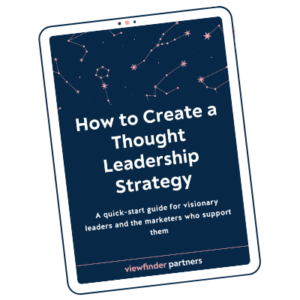Last week, I caught up with someone I’ve known online for a couple of years (hi, Megan!). She asked me what I’ve been working on lately. Really, her question was more like, “I’ve been reading your newsletter. But…what do you actually…do?”
Great question.
When someone says they’re a “consultant,” the brass tacks of what they really do all day can vary so much. And “thought leadership consultant,” a job I literally made up for myself, is understandably a little nebulous.
So here’s what I told her — how I knew I wanted to be a thought leadership consultant, and what I actually do.
My career evolved as content marketing evolved
I’ve worked in online marketing since 2008. That’s only 12 years ago, but for some perspective, when I started my first marketing job, my cell phone did not have Internet access. 🤯 In those early days, content marketing was mostly about creating a bunch of content — about quantity and volume. We all wanted to “drive traffic.” Traffic numbers going up = good.
Later, when I started working at an agency, I remember that we used to recommend 5 blog posts a week to many of our clients. That kind of quantity seems ridiculous now, but it was totally normal then. The primary goal was driving traffic by answering people’s questions for which there were not already answers online. Publish, publish, publish. Traffic, traffic, traffic.
I’m oversimplifying, sure, and this all seems quaint with the benefit of a few years’ distance. But I think it’s safe to say that most people were pretty focused on quantity in the early days of content marketing. (Ryan Law describes the race for “first mover advantage” in content, and what came after, in this very well-done explainer.)
Finding my focus: thought leadership
Because we needed a lot of content, I learned to study my client companies and find as many potential authors as I could. Who could author the next post? Who knew something about this topic? Who could tell me more about the questions customers ask?
Now, it’s clear that I was looking for thought leaders.
I’d find an author at the company — someone with experience and answers. I’d interview the author on the phone, write the piece in their voice, get their feedback, and publish. I learned how to be a better interviewer, how to write in other people’s voices, and how to get to the good stuff as quickly as I could.
Those interviews became the most interesting part of my job. I could do the keyword research, sure. I could make editorial calendars and compile analytics reports about all that traffic we were driving. But mostly, I cared about the ideas — digging them up, calling them out, polishing them, and using the ideas to make an impact.
And as content marketing matured, and the Internet got louder and stuffed to the gills with all of those eager marketers’ five blog posts a week, the competition for an audience’s attention got very stiff. Just adding another blog post to the pile didn’t accomplish much anymore. Too much content could actually hurt you if it wasn’t talking to the right audience, or about the right topics, or with the right tone.
It wasn’t enough to just share the what. Brands needed to start revealing the who and the why. And that’s exactly what I was interested in.
I knew that digging up the who and the why was the part of my job I liked the most, but I’m not sure I truly valued how important it was until the summer of 2019 when I started working with a career coach. Under her guidance, I took the CliftonStrengths assessment and, ta-da, learned that my superpower is digging up ideas. I like to collect a lot of information and really go deep on the most interesting ideas…
So, I turned that part of my job into my whole job.
How I work with thought leaders
Here’s what my client relationships look like.
I work with visionary leaders — people who have a big idea (or a ton of little ideas) that they’re passionate about. Often these visionaries are company founders who have turned their big idea into a solution. This year, most of my clients have been tech companies (people who turned a vision into a product) and professional services firms (people whose ideas are their product).
I love idea people — people who get talking about an idea and just can’t stop. But idea people sometimes struggle to constrain their brainstorms, distill their big ideas, and focus on clarifying, polishing, and bringing people along.
That’s where I come in. I think of myself as a “thought leader whisperer.” A leader or their marketing team hires me. I interview the marketing people to understand the business goals, marketing direction, and any existing thought leadership strategy. Then I start my work with the thought leader.
Here’s my process:
-
I identify the thought leadership goals. (Are we trying to influence an audience to change their behavior? Establish a new concept in an industry? Drive awareness of a brand or a certain solution? Does the thought leader want to profit from their actual thought leadership and schedule more speaking events or publish a book?)
-
I clarify the core audience the thought leader is talking to.
-
I dig up the big ideas. <<This is the core part of my work with thought leaders. They could have a lot of well-worn ideas about their industry, but I look for the most interesting themes, the ideas that keep coming up, and the perspectives that are unique and differentiated. I lead long brainstorms to dig up the best ideas and turn them into simplified, polished messages that a broader audience could understand.
-
I research the competition in the space. Not just the direct competitors for their buyers’ business, but also the competitors in the broader market of ideas. Who else is already talking about this? What’s missing in the space?
Once we’ve addressed those questions, we can actually develop a process for creating thought leadership content. I don’t do high-volume writing anymore. Instead, I think of my work as “strategic ghostwriting” — writing key pieces for maximum impact.
For some of my clients, that’s a newsletter like this one. Sometimes it’s a weekly podcast. Or two blog posts a month. Sometimes it’s a quarterly opinion article in an outside publication, or keynote scripts, or even internal communication to their employees. But once we’ve established the strategy and polished the ideas, we’re able to talk about them in any kind of content format. Because it’s not the what that makes an impact. It’s the why and the who.
I’ve found that this thought leadership work is often very helpful for the marketing teams who support the thought leaders. They are doing the heads-down work of execution, but don’t have enough insight into their bosses’ big ideas. They also need to understand the why to do better work.
Does this description match what you think “thought leadership consultants” do? Do you follow a similar process on your team? What ideas does this stir up for you? I’d love to hear.
P.S. If you’re struggling to find your voice in the middle of…all this…you might find this framework helpful: 3 ways to think in public. Are you a beacon, a curator, or a challenger?







